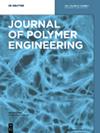利用静电喷雾技术制备万古霉素负载聚乳酸-聚乙二醇-聚乳酸微球及其特性
IF 1.7
4区 工程技术
Q4 POLYMER SCIENCE
引用次数: 0
摘要
万古霉素的持续释放仍有待研究。聚乳酸(PLA)因其良好的生物相容性被广泛应用于生物医学领域,尤其是在药物控释领域。本研究采用聚乙二醇(PEG)对聚乳酸进行改性,以提高材料的亲水性。通过红外和核磁表征证明了嵌段共聚物的合成,并测试了其亲水性。采用同轴电喷雾法固定万古霉素,并以 PLA-PEG6000-PLA 作为外壳层。探讨了该材料下的同轴电喷参数,系统研究了浓度、电压和温度对微球形成的影响。确定的最佳参数为:浓度 20 wt%、温度 35 °C 和电压 14 kV。经计算,最大包封率和载药量分别为 89.54 ± 1.22 % 和 15.33 ± 0.97 %,载药微球在 24 小时内的累积释放量小于 45 %,缓释时间超过一个月。载药微球显示出良好的持续释放性和对猝灭释放的良好控制。本文章由计算机程序翻译,如有差异,请以英文原文为准。
Preparation and properties of vancomycin-loaded PLA-PEG-PLA microspheres by electrostatic spray technology
Vancomycin in sustained release still needs to be investigated. Polylactic acid (PLA) was widely used in the biomedical field for its good biocompatibility, especially in the field of controlled drug release. In this study, polyethylene glycol (PEG) was used to modify PLA to improve the hydrophilicity of the material. The synthesis of the block copolymers was proven by infrared and nuclear magnetic characterization and the hydrophilicity was tested. Vancomycin was immobilized by coaxial electrospray, and PLA-PEG6000 -PLA was used as the shell layer. The parameters of coaxial electrospray under this material were explored, and the effects of concentration, voltage and temperature on the formation of microspheres were systematically studied. The optimum parameters were determined as follows: concentration 20 wt%, temperature 35 °C and voltage 14 kV. The maximum encapsulation rate and drug loading were calculated to be 89.54 ± 1.22 % and 15.33 ± 0.97 %, respectively, and the cumulative release of drug-loaded microspheres was less than 45 % in 24 h with a slow releasing time of more than one month. The drug loaded microspheres showed good sustained release and good control of burst release.
求助全文
通过发布文献求助,成功后即可免费获取论文全文。
去求助
来源期刊

Journal of Polymer Engineering
工程技术-高分子科学
CiteScore
3.20
自引率
5.00%
发文量
95
审稿时长
2.5 months
期刊介绍:
Journal of Polymer Engineering publishes reviews, original basic and applied research contributions as well as recent technological developments in polymer engineering. Polymer engineering is a strongly interdisciplinary field and papers published by the journal may span areas such as polymer physics, polymer processing and engineering of polymer-based materials and their applications. The editors and the publisher are committed to high quality standards and rapid handling of the peer review and publication processes.
 求助内容:
求助内容: 应助结果提醒方式:
应助结果提醒方式:


